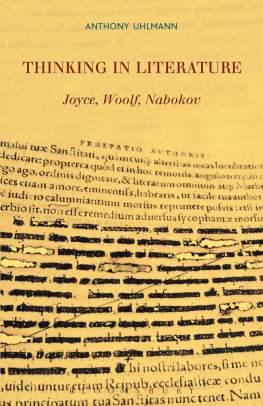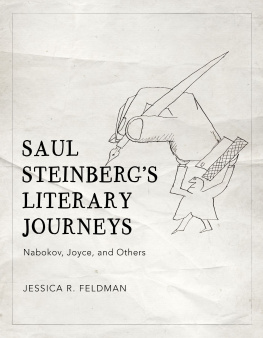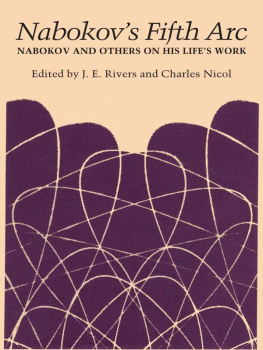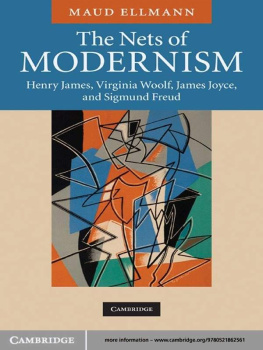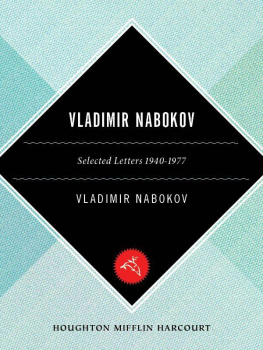Anthony Uhlmann - Thinking in Literature: Joyce, Woolf, Nabokov
Here you can read online Anthony Uhlmann - Thinking in Literature: Joyce, Woolf, Nabokov full text of the book (entire story) in english for free. Download pdf and epub, get meaning, cover and reviews about this ebook. year: 2011, publisher: Bloomsbury USA, genre: Religion. Description of the work, (preface) as well as reviews are available. Best literature library LitArk.com created for fans of good reading and offers a wide selection of genres:
Romance novel
Science fiction
Adventure
Detective
Science
History
Home and family
Prose
Art
Politics
Computer
Non-fiction
Religion
Business
Children
Humor
Choose a favorite category and find really read worthwhile books. Enjoy immersion in the world of imagination, feel the emotions of the characters or learn something new for yourself, make an fascinating discovery.
- Book:Thinking in Literature: Joyce, Woolf, Nabokov
- Author:
- Publisher:Bloomsbury USA
- Genre:
- Year:2011
- Rating:3 / 5
- Favourites:Add to favourites
- Your mark:
- 60
- 1
- 2
- 3
- 4
- 5
Thinking in Literature: Joyce, Woolf, Nabokov: summary, description and annotation
We offer to read an annotation, description, summary or preface (depends on what the author of the book "Thinking in Literature: Joyce, Woolf, Nabokov" wrote himself). If you haven't found the necessary information about the book — write in the comments, we will try to find it.
Thinking in Literature: Joyce, Woolf, Nabokov — read online for free the complete book (whole text) full work
Below is the text of the book, divided by pages. System saving the place of the last page read, allows you to conveniently read the book "Thinking in Literature: Joyce, Woolf, Nabokov" online for free, without having to search again every time where you left off. Put a bookmark, and you can go to the page where you finished reading at any time.
Font size:
Interval:
Bookmark:

Bloomsbury T&T Clark
An imprint of Bloomsbury Publishing Plc
Imprint previously known as T&T Clark
50 Bedford Square | 1385 Broadway |
www.bloomsbury.com
2011 Anthony Uhlmann
All rights reserved. No part of this book may be reproduced, stored in a retrieval system, or transmitted, in any form or by any means, electronic, mechanical, photocopying, recording, or otherwise, without the permission of the publishers.
Library of Congress Cataloging-in-Publication Data
ISBN 978-1-441-19990-4
Digital conversion katebroome.co.nz
For Nicola, Alistair, Andrea, Liam and Xavier
I would like to acknowledge the support of the Australian Research Council, as this research was supported under the Australian Research Councils Discovery Projects funding scheme (project number DP0559731). I also wish to acknowledge the Research Office, the School of Humanities and Languages, the College of Arts, and the Writing and Society Research Group at the University of Western Sydney for their generous support of this project.
I would also like to thank a number of people who helped, in various ways, to direct my thinking. At the University of Western Sydney: Ivor Indyk, Gail Jones, Dimitris Vardoulakis, Chris Fleming, Roger Dean, Wayne McKenna, Jane Goodall, Sara Knox, Lindsay Barrett, Chris Conti, and Judith Snodgrass. At the University of New South Wales: Helen Groth; at Macquarie University: Paul Sheehan; and Brian Boyd at Auckland University. I would also like to thank a number of research students at the University of Western Sydney with whom I fruitfully discussed most of the ideas developed here: Jay Johnston, Ben Denham, Jason Tuckwell, James Gourley, Stephen McLaren, and Gavin Smith. I was also fortunate to be able to discuss elements of this research internationally, and am particularly grateful to Bruno Clment in Paris.
I would like to thank my wife Andrea Curr for her terrific support (both moral and technical) and our children Liam, Xavier, Nicola, and Alistair for their love.
I would also particularly like to thank the team at Continuum, and particularly Haaris Naqvi, whose enthusiasm for the project made me see the benefits of approaching Continuum.
Versions of material that appear in this book have appeared in different forms, with different points of emphasis in various collections of essays: Literature and Sensation , edited by Anthony Uhlmann, Helen Groth, Paul Sheehan, and Stephen McLaren (Cambridge Scholars Publishing, 2009), The Edinburgh Companion to Virginia Woolf and the Arts , edited by Maggie Humm (Edinburgh: Edinburgh University Press, 2010), Becketts Proust/Deleuzes Proust , edited by Mary Bryden and Margaret Topping (London: Palgrave, 2009), Deleuze and Performance , edited by Laura Cull (Edinburgh: Edinburgh University Press), and Spinoza Now , edited by Dimitris Vardoulakis (University of Minnesota Press, 2011). The publishers of these works are gratefully acknowledged.
I wish to thank my brother, Paul Uhlmann, for permission to use his photograph as cover for this book, and my sister Amanda who spoke with me about mathematics and patterns.
Finally, I want to thank my mother Mary, with whom I discussed Spinoza one quiet morning, and who made me understand that all of this had meaning.
The term aesthetic has been criticized in recent years, and not without reason (see, for example, Eagleton 1991; Connor 1999). The substance of the critique rests, first, on the view that the term has taken on so many, often incompatible, meanings that it has itself become meaningless, and second, that the term has been used largely for social and political purposes: to buttress certain kinds of artistic practice and generate cultural capital.
While the force of this critique needs to be acknowledged, I do not agree with the contention that the term itself needs to be abandoned. The term aesthetic is not alone in being a site of contestation; it is not alone in being used in many ways; it is not alone in being made use of for social and political agendas. In short, rather than having to be abandoned, it needs to be used with care.
In this study, the term aesthetic will be used in line with its original meaning, as it was developed by Alexander Baumgarten in his 1735 study, Reflections on Poetry : that is, related to the kind of perceptual cognition, or thought, developed through sensations and perceptions. The kind of thought, that is, which Baumgarten felt had been excluded by the discussions of thought developed by the seventeenth-century rationalists (in particular Descartes and Leibniz). While much of Baumgartens system has dated and he clearly considers the perceptions of the senses simply inferior to the faculty of logic, his distinction remains useful. He offers the following definition:
The Greek philosophers and the Church fathers have already carefully distinguished between things perceived [] and things known []. It is entirely evident that they did not equate things known with things of sense, since they honored with this name things also removed from sense (therefore, images). Therefore, things known are to be known by the superior faculty as the object of logic; things perceived [are to be known by the inferior faculty, as the object] of the science of perception, or aesthetic. (Baumgarten 1954: p. 78)
One might argue with Baumgarten in suggesting that the dichotomy is too stringently defined here; in suggesting, with Deleuze, Nussbaum, Damasio, and others, that logic is implicated within sensory perception. Yet, the distinction remains useful because it allows us a space in which to claim an importance for creative expression in literature and the other arts: while they too might well make use of certain kinds of logic, the logic they develop is, properly speaking, a logic of sensations, a logic of perception.
In short, then, I will understand aesthetic to refer to understandings of perception, and aesthetic method to refer to the manner in which writers (here, more specifically, Modernist novelists, though I also touch upon dramatic and critical writings by these authors) make use of these understandings and of sensations and perceptions in developing their works as meaningful expressions. To put this another way, I am interested in how writers develop works which can be used to think through sensation and perception, and which, further, shed light on the nature of perceptual thought itself.
Understood in this way a consideration of aesthetic method involves the examination of what a work of literature (especially the novel) can do. Here the question will be narrowed further, to consider specific works within a specific period: the Modernist era, here confined to a period from about 1910 to the mid-1930s. This was a period of great achievement and exploration in the form of the novel, and it has been chosen in part because of this, and because the question of the nature of thought itself was an overt concern for the major writers I have chosen to consider in this study: James Joyce, Virginia Woolf, and Vladimir Nabokov.
Early and extremely influential receptions of the Modernist fiction developed by Joyce, Woolf, and others such as William Faulkner, linked these works to the representation of cognitive perception, through the concept of the stream of consciousness. This term was adapted from the American philosopher William James (see James 2001: pp. 1843), and particularly emphasized the strong interest in interior monologue apparent in certain of the works of Joyce and Woolf in particular (see, for example, Humphrey 1954; Kumar 1963; Freidman 1955). The term has atrophied over the years, and it is fair to claim that the concept of the stream of consciousness has born little fruit recently, or for many years. This is in large part because the concept itself is reductive: it simply does not adequately account for the various elements brought to bear in these novels, which, for the most part, do not exclusively limit themselves to the mode of interior monologue.
Font size:
Interval:
Bookmark:
Similar books «Thinking in Literature: Joyce, Woolf, Nabokov»
Look at similar books to Thinking in Literature: Joyce, Woolf, Nabokov. We have selected literature similar in name and meaning in the hope of providing readers with more options to find new, interesting, not yet read works.
Discussion, reviews of the book Thinking in Literature: Joyce, Woolf, Nabokov and just readers' own opinions. Leave your comments, write what you think about the work, its meaning or the main characters. Specify what exactly you liked and what you didn't like, and why you think so.

